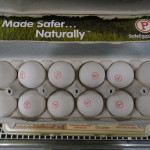 Eggs are considered potentially risky for some people. The Food and Drug Administration’s (FDA) food code puts them on the TCS (foods that need time and temperature control for safety) list.
Eggs are considered potentially risky for some people. The Food and Drug Administration’s (FDA) food code puts them on the TCS (foods that need time and temperature control for safety) list.
The major concern is Salmonella which ranks second (11%) of all foodborne illnesses in the United States. (Note: Norovirus is first with 58%).
For the average healthy adult, the risk of getting sick from a Salmonella contaminated egg is very low. It is estimated that as few as three in 10,000 eggs are contaminated. But it’s important to remember that children, the elderly, pregnant women and those people with weakened immune systems are more susceptible to a foodborne illness. I know a sanitarian that says she’ll eat an undercooked egg, but is careful not to give one to her children.
 Typically, people infected with Salmonella develop diarrhea, fever, and abdominal cramps between 12 and 72 hours after infection. The illness usually lasts 4 to 7 days, and most individuals recover without treatment. In some cases, diarrhea may be so severe that the patient needs to be hospitalized.
Typically, people infected with Salmonella develop diarrhea, fever, and abdominal cramps between 12 and 72 hours after infection. The illness usually lasts 4 to 7 days, and most individuals recover without treatment. In some cases, diarrhea may be so severe that the patient needs to be hospitalized.
One way to reduce the risk from Salmonella bacteria in eggs is to cook them until they reach at least 145 degrees F. At this temperature both the whites and yolks are firm. Yes, this means the yolks should not be runny. This rules out sunny-side-up, over-easy, soft boiled, runny scrambled and my poached egg. For dishes containing eggs like quiche and souffle, they should be cooked until an internal temperature of 160 degrees Fahrenheit is reached.
There is an alternative — but it does cost a little more — use pasteurized shell eggs. These eggs can be served undercooked without a risk. While these products look like and can be used like regular “shell” eggs, they have been heated to destroy potential bacteria. Look for them in the egg section of the grocery store. But read the packages carefully, make sure the carton says “pasteurized”. Some “specialty” shell eggs such as organic, lower cholesterol, higher vitamin — are NOT pasteurized. Usually, pasteurized eggs have a marking on the shell itself to help you not confuse it with “regular” eggs.
 Other sources of pasteurized egg products include whole-out-of shell eggs (liquid eggs—frequently used in restaurants) and low-cholesterol egg products (made primarily with egg whites). These pasteurized products usually come in containers that look like little milk cartons and can be found both fresh and frozen in most grocery stores. They are great if you have a recipe that calls for an uncooked egg such as egg nog, hollandaise sauce, homemade mayonnaise, and uncooked ice cream and will be serving it to potentially “at-risk” individuals.
Other sources of pasteurized egg products include whole-out-of shell eggs (liquid eggs—frequently used in restaurants) and low-cholesterol egg products (made primarily with egg whites). These pasteurized products usually come in containers that look like little milk cartons and can be found both fresh and frozen in most grocery stores. They are great if you have a recipe that calls for an uncooked egg such as egg nog, hollandaise sauce, homemade mayonnaise, and uncooked ice cream and will be serving it to potentially “at-risk” individuals.
Cheryle Jones Syracuse, MS. Professor Emeritus, The Ohio State University
References:
Food Safety Talk 156: Rank the Kato’s, June 16, 2018, http://foodsafetytalk.com/food-safety-talk/2018/6/16/food-safety-talk-156-rank-the-katos
Just a poached egg https://news.nutritioneducationstore.com/just-a-poached-egg/
Estimates of Foodborne Illness in the United States https://www.cdc.gov/foodborneburden/2011-foodborne-estimates.html
What Causes Food Poisoning? Centers for Disease Control and Prevention https://www.cdc.gov/foodsafety/foodborne-germs.html
Safe Minimum Internal Temperature Chart https://www.fsis.usda.gov/safetempchart





